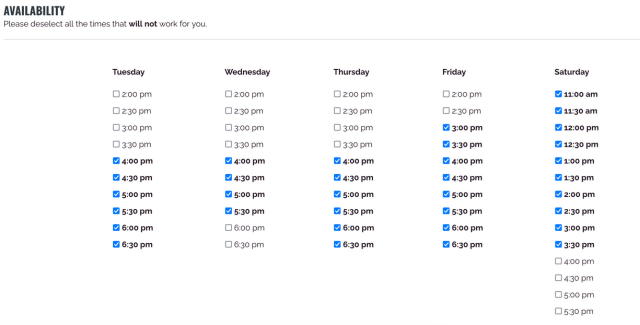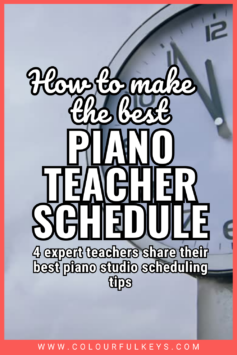Whether you run a multi-teacher studio, a micro-studio or exclusively teach group lessons, creating a piano studio schedule can feel like a gigantic Tetris puzzle. (Remember that game? 🎮) Once you have one piece in place, it can take a while to figure out which piece goes next – or worse yet, that piece knocks something else out of place.

We’ve brought together four expert piano teachers to share their unique ways of creating their annual music studio schedule, in the hope of making your own process as simple and straightforward as possible.
Melanie Bowes: Scheduling Group Piano Classes

In many ways, scheduling group classes has to work quite differently from scheduling individuals. Who am I going to put together in a class? What if they can’t all make the time?
The good news is, once I’ve set my overall timetable and class descriptions, I’m all set.
Paid Trials and Giving Notice
The first things to consider when scheduling group classes are your studio policies around trials and giving notice.
I don’t offer free trials because I need to know exactly who is going to show and, let’s face it, “free” can lead to no-shows. Instead, I offer three-week paid trials which are bookable on my website.
Scheduling Group Dynamics
The other consideration is carefully managing who is in which group. Therefore I don’t allow booking of specific classes online, and I require half a term’s notice (approx. 6 weeks) before discontinuing class.
This way, I know exactly who I have the following term, and I’ll know if I have space for new students or whether to move anyone to a different program.
Visit keynotes-music.com to find out more about Melanie and her group piano teaching studio.
Christine Mulhall: Make Your Schedule Work for You

When planning out my schedule for the year, I always think ahead to plan my ideal hours and how I want the school year to look before fitting in the students. And I do not give in!
Start Early
I always ask parents before the end of the term if they want to continue with lessons. I find that keeping the same time slot from year to year is much easier for the parent to remember, and saves a ton of planning.
Different Types of Students
Here are some of the considerations I like to keep in mind for different types of students:
- Place students who are absent more than others either first or last in the day. That way you’ll start later or finish earlier, rather than have a big gap in your teaching day.
- Group preschoolers together into the mornings.
- Young schoolchildren tire easily after a long day at school, so I prioritise these students in my schedule. A quick bite to eat after school and then their lesson is more enjoyable for both student and teacher alike.
- If you teach any children with autism or special needs, you may have to make their most effective time a priority in the schedule.
- Older students can cope with staying up later in the evenings, so encourage them to fill the later time slots.
The Final Schedule
I offer a flexible schedule for my students, so I like to use pen and paper. I can highlight different students depending on whether they’re face-to-face or online and can easily make changes by erasing them.
Once you think you have the final schedule (is there ever such a thing?), you may have one or two students who need to change.
“Aggggghhhhhh…..!!!!!” I hear you say. 😵
The next time you’re creating your piano studio schedule, remain firm on your overall teaching hours/personal schedule. Even if you lose a student or two because of it, you’ll be a happier and more productive teacher if you find new students who are a better fit.
Read more about Christine and her studio on her website.
Juanita Stauffer: Autumn Scheduling in the Summer

Fall scheduling begins in May when I accept my current students’ registrations. They register via Google Forms and block off times they are NOT available. Then in June, I’ll do a mock schedule to make sure that everyone will fit and to see how many new students I can accommodate.
I send out the new schedule by the middle of August and make any adjustments necessary at that time.
Generally speaking, my students keep the same or similar times from year to year but sometimes, depending on activities, they will request a change. I value long-term students and try to accommodate their requests. In turn, they’ll usually make adjustments as needed to help make the schedule work for everyone.
Learn more about Juanita’s studio on her website or @allegropianomusic on Instagram and Facebook.
Nicola Cantan: Opt-Out Scheduling Preferences

It seems we’ve saved the most complicated scenario for last! Scheduling is especially complicated in my multi-teacher studio with different lesson formats and locations.
But even if you run a smaller studio out of your home, you can hopefully pull out a nugget or two to help improve your own scheduling dilemmas.
Start Early
In many ways, the most important part of my scheduling process begins before I start making my timetable. Every year in June, I send a registration form to my students for the next academic year. They must fill in this form and pay the registration fee by the mid-July deadline in order to secure their spot for September.
What Times Don’t Work
As part of that form, I ask about their scheduling preferences and I always show it in an opt-out format. By “opt-out” I mean that the parent has to cross out or uncheck the times they cannot make, rather than selecting the times that will work best.
This is a tweak I made years ago and I have found it leads to folks leaving a lot more of the week available for scheduling lessons. If you ask when you can do it, people tend to just pick their favourite times. 🤪
Here’s how that used to look on my old paper form:

And once my piano parents filled it out, it would look something like this:

I now do this form online, using checkboxes like this:

So parents fill it out by deselecting, like this:

Before you ask me, no, I don’t know how to do this in Google Forms. This is a Gravity Form, which is a WordPress plugin. You can’t use that without a self-hosted WordPress site.
When it comes to actually making the schedule, I download the spreadsheet which includes all my parents’ responses. Then I start the process of matching up buddy students and making the puzzle pieces fit together.
In this stage, I start with a separate spreadsheet which has rows of 5-minute increments, like this:

Finally, the real work begins. I start filling in students using merged cells the correct length of their lesson slot. I also colour-code everything by type of lesson and whether they are at the studio or at the students’ homes.
Contact Piano Parents
Once I have a temporary schedule laid out, I change all the names to italic and start contacting parents to confirm their spots. When I email a student’s family, I change their name to bold and when they confirm I change it to regular text. That way I can easily see, at a glance, who I’ve yet to check with and who has yet to reply.
When all that is done, I’ll have a schedule something like this:

And I transfer that to My Music Staff so the teachers can see their timetables.
Chances are, your studio is a helluva lot less complex than mine. You likely don’t have multiple teachers, lesson formats and locations. So I hope this whole description gives you some rose-tinted spectacles the next time you’re grumbling about creating your own piano studio schedule. 🤓
At Colourful Keys, we have an entire web page to help you run your music studio teaching business more efficiently and effectively. Check it out today!

How do you create your own music teaching studio schedule?
Do the scheduling processes described by these 4 teachers give you any ideas on improving your own approach? Share your thoughts in the comments below.
My method is closest to Juanita’s. Every summer I do a fruit basket upset. I have about 40 students which I divide into 4 groups. Students are prioritized into groups based on length of time they’ve been with me, how committed they are to lessons, multiple students in one family, student is a really good fit for my studio, timezone needs, etc. I have an editable Google sheet with my available slots. In late July I contact the first group of students and say “first come first serve”. They can select their favorite time, and write it on the Google sheet, now or later, but the longer they wait, their options become more limited. (Some students prefer to wait until other extracurriculars are locked down.) One week later I send out the second batch and shoot a reminder to anyone in the first batch that still hasn’t selected a slot. Third week, send to third batch and send followup reminders. Same for fourth week.
It’s interesting to see how the schedule changes from year to year. Sometimes a student who joined mid year accepted a less than ideal spot because that’s all I had available at that point, but for whatever reason made the priority list by summer time. Now they get to select their ideal slot. Who’s in which slot is generally quite different each year. My available teaching hours remain fairly consistent. Many of my students take lessons year round, so I choose an arbitrary date mid August to begin the new schedule. The refreshed schedule is always a delight!
This is a great idea!